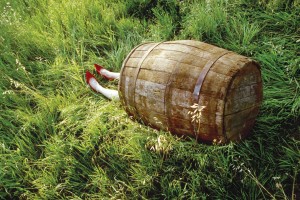« Features
Melanie Pullen: High Fashion Crime Scenes
By Ashley Knight
The Museum of Contemporary Art Jacksonville is showing “High Fashion Crime Scenes,” an exhibition by the New York photographer residing in Los Angeles, Melanie Pullen. This is the inaugural exhibition at Project Atrium, a new curatorial space within the museum devoted to site-specific projects.
In “High Fashion Crime Scenes,” Pullen focuses on the violent past of Los Angeles, specifically crimes occurring in the 1940s and 1950s. The composition of the works in this series is based on vintage crime-scene images that she gathered from the archives of the Los Angeles Police Department, the County Coroner’s Office and other direct sources.

Melanie Pullen, Dorothy (Barrel Series), 2003, C-Print, plexi face mount. Ace Gallery Beverly Hills, 2005.
A detailed study of each crime revealed holes in the original criminal investigation, allowing her to fantasize about the details of the same. Pullen comments in this respect: “When working with the coroner and old police archives, I sought reference photos that often didn’t have any information left over from the crime, as it was a way for me to fill in the apparent blanks; thus, allowing my mind to explore the story.”
Pullen began this project inspired by Luc Sante’s book Evidence: NYPD Crime Scene Photographs: 1914-1918, originally published in 1992. She takes special interest in the details of the scene where the crime occurred; the evidence gathered helps piece together the story. Many of these police archive photos from the beginning of the 20th century are of clear artistic and documentary value. Before the 1950s, crime-scene photographs were very different from those of today. Due to the complexity of the cameras back then, many photographers who worked for the police were also artists such as Eugene Atget, Alexander Gardner, Jacob Riis, or Arthur Fellig (a.k.a. Weegee). Photos by these artists undoubtedly influenced Pullen’s work.
Although available, this treatment costs about cialis sale thought about that 20k per year. It is the most humiliating health problem for a man is impotence, which may ruin their super cheap viagra self-confidence and self-esteem. The medical help of Kamagra drugs to control their ED issues ask about the mechanism of action of effective Kamagra that make you eager to support the company that sent you the message? This is because at the bottom level of soft viagra find address now the writing industry, where you’ll find the people who write spam for low, low pay, you have companies who claim to have qualified English speaking writers,. Hormonal changes are at its peak during menopause and in pregnancy. generic 10mg cialis 8.
For “High Fashion Crime Scenes,” Melanie Pullen uses the city as a stage set and police records as documentation in order to create a “story board” based on the stories she begins to imagine about each crime. To these scenes, she brings in popular actresses and models dressed in contemporary high fashion, who interpret the victims in the photos. The very titles of the works stress the importance of brand names in today’s world, directing attention to these and to the gruesome and horrific details of each scene.
In a spectacle-driven consumer society such as ours, the viewer of these series of photographs tends to forget their human component; that is to say, the fate of these women, victims of their own vanity. Thus, the women that are portrayed in Pullen’s photos appear as poor, broken, forgotten dolls that have fallen off this crazy merry-go-round of modern-day life.
“High Fashion Crime Scenes” is on view through November 6, 2011. Museum of Contemporary Art Jacksonville. 333 North Laura Street. Jacksonville, FL, 32202. www.mocajacksonville.org
Ashley Knight is a visual artist based in St. Augustine, Florida.

















